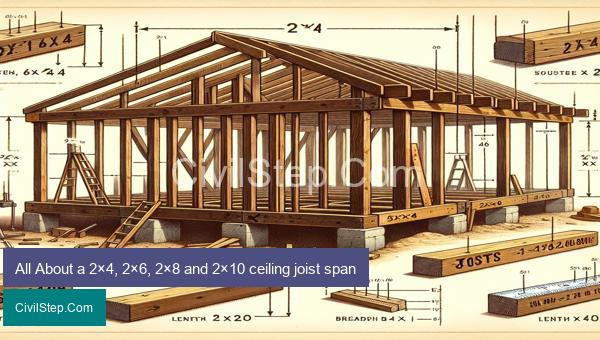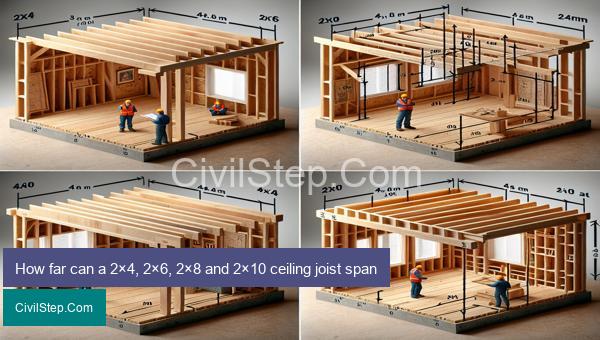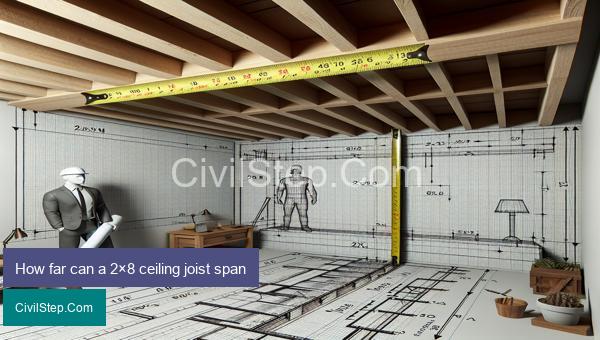
When it comes to building or renovating a home, understanding the ins and outs of the different building materials is crucial. One of the most important components of any structure is the ceiling joist, which provides essential support for the roof and keeps the walls in place. Among the various sizes available, the 2×4, 2×6, 2×8, and 2×10 ceiling joists are some of the most commonly used options in residential and commercial construction. In this article, we will delve into the specifics of these different joist sizes, including their span capabilities, to help you make informed decisions for your building project. Whether you are a homeowner, contractor, or simply curious about construction, stay tuned to learn all
How far can a 2×4, 2×6, 2×8 and 2×10 ceiling joist span

Ceiling joists are horizontal structural members that support the weight of a ceiling and the load of any elements attached to it, such as light fixtures or ceiling fans. In residential construction, lumber is commonly used to construct ceiling joists due to its strength, durability, and cost-effectiveness. The size of the lumber used for ceiling joists can significantly impact their span, or the distance between supports that a joist can cover without sagging or bending. In this article, we will discuss the span capabilities of four common sizes of ceiling joists: 2×4, 2×6, 2×8, and 2×10.
2×4 Ceiling Joists:
A 2×4 joist has a width of 3.5 inches and is typically used for interior walls and non-load bearing applications. When used as a ceiling joist, the span capabilities are limited. According to the American Wood Council’s span table, a 2×4 ceiling joist can span up to 10 feet for a live load of 20 pounds per square foot (psf) or 12 feet for a live load of 10 psf. However, these spans are not recommended, and it is generally advised to limit the span to a maximum of 8 feet for a live load of 20 psf and 10 feet for a live load of 10 psf.
2×6 Ceiling Joists:
A 2×6 joist has a width of 5.5 inches and is commonly used for floor and ceiling joists in residential construction. It is a versatile size that can span longer distances than a 2×4 joist. According to the span table, a 2×6 ceiling joist on 16-inch centers can span up to 13 feet 6 inches for a live load of 20 psf, and 15 feet 6 inches for a live load of 10 psf. When placed on 24-inch centers, the maximum span increases to 16 feet 4 inches for a live load of 20 psf and 18 feet 3 inches for a live load of 10 psf.
2×8 Ceiling Joists:
A 2×8 joist has a width of 7.25 inches and is commonly used for heavy-duty applications such as floor and ceiling joists in larger structures. The increased width of a 2×8 joist allows for longer spans. When placed on 16-inch centers, a 2×8 ceiling joist can span up to 17 feet 11 inches for a live load of 20 psf and 21 feet 9 inches for a live load of 10 psf. When placed on 24-inch centers, the span capabilities increase to 20 feet 3 inches for a live load of 20 psf and 23 feet 9 inches for a live load of 10 psf.
2×10 Ceiling Joists:
A 2×10 joist has a width of 9.25 inches and is commonly used for heavy-duty applications such as roof rafters and floor and ceiling joists in larger structures. The increased width of a 2×10 joist allows for even longer spans. When placed on 16-inch centers, a 2×10 ceiling joist can span up to 22 feet 9 inches for a live load of 20 psf and 28 feet 5 inches
How far can a 2×4 ceiling joist span

Ceiling joists are horizontal wood or steel beams that support the weight of the floor or roofing materials above them. They play a crucial role in the stability and structural integrity of any building. When it comes to the size and spacing of ceiling joists, it is important to consider the span – or the distance between supporting walls or beams – to ensure they can adequately bear the load.
In the construction industry, 2x4s are commonly used as ceiling joists due to their cost-effectiveness and ease of installation. But how far can a 2×4 ceiling joist span? The answer to this question depends on several factors, including the type of wood, spacing between the joists, and the type of load it will be supporting.
Type of Wood
The type of wood used for 2×4 ceiling joists can significantly impact their strength and durability. Typically, softwoods, such as pine, fir, and spruce, are used for construction purposes. However, hardwoods like oak and maple can also be used for joists.
Softwoods are generally less dense than hardwoods, which means they may not be able to span as long of a distance. This is why it is essential to use high-grade, properly dried lumber when constructing ceiling joists to ensure maximum strength and stability.
Spacing Between Joists
The spacing between 2×4 ceiling joists is another critical factor that determines their span. Standard spacing for ceiling joists is typically 12 inches or 16 inches on center (OC). This means that the distance between the center of one joist to the center of the next one is 12 or 16 inches, respectively.
The wider the spacing between joists, the shorter the span can be. For a 2×4 ceiling joist with 12-inch OC spacing, the maximum span is approximately 10 feet. In contrast, for the same joist with 16-inch OC spacing, the maximum span is about 7 feet 7 inches.
Type of Load
The type of load that the ceiling joist will be supporting also plays a crucial role in determining its span. A uniformly distributed load, meaning equal weight distributed across the entire surface, can span farther compared to a concentrated load, where the weight is placed in a single area.
For example, a 2×4 ceiling joist with 12-inch OC spacing can span around 10 feet if supporting a uniformly distributed load. However, if the same joist is supporting a heavy object in one area, the span will need to be shorter, typically around 8 feet.
Additionally, the type of load can also depend on the function of the room or structure. For instance, a ceiling joist supporting a second-floor living area will need to withstand more weight compared to a ceiling joist supporting a single-story garage.
In conclusion, the span of a 2×4 ceiling joist can vary depending on the type of wood, spacing between joists, and type of load it will be supporting. It is essential to consult local building codes and a structural engineer to ensure that your ceiling joists are properly sized and spaced for the intended use.
How far can a 2×6 ceiling joist span

Ceiling joists are an important structural element in any building, as they provide support to the ceiling and the roof above. The size and spacing of the ceiling joists play a crucial role in determining the strength and stability of a building. One common type of ceiling joist used in construction is the 2×6 joist, which is a piece of lumber measuring 2 inches by 6 inches in cross-section. In this article, we will discuss the span of a 2×6 ceiling joist, which refers to the maximum distance that the joist can span without any additional support.
The span of a 2×6 ceiling joist primarily depends on the type of wood used, the grade of the wood, and the spacing between the joists. The most common types of lumber used for ceiling joists are spruce, pine, and fir (SPF) and southern yellow pine (SYP). The strength of these woods is measured in pounds per square inch (psi) and is categorized into different grades. The higher the grade, the stronger the wood.
For ceiling joists, the most commonly used grades are #2 and #1. A #2 grade 2×6 SPF joist has a bending strength of 900 psi, while a #1 grade 2×6 SPF joist has a bending strength of 1100 psi. On the other hand, a #2 grade 2×6 SYP joist has a bending strength of 1250 psi, while a #1 grade 2×6 SYP joist has a bending strength of 1600 psi. Therefore, a 2×6 SYP joist can span further than a 2×6 SPF joist.
The spacing between ceiling joists is typically 16 inches or 24 inches on center. This means that the distance between the center of one joist to the center of the next joist is either 16 inches or 24 inches. The wider the spacing, the weaker the ceiling system will be. This is because the farther apart the joists are, the more weight they have to support, leading to an increase in deflection.
Based on the guidelines from the International Residential Code (IRC), a #2 grade 2×6 SPF joist spaced at 16 inches on center can span up to 11 feet 8 inches, while a #1 grade 2×6 SPF joist can span up to 12 feet 10 inches. A #2 grade 2×6 SYP joist spaced at 16 inches on center can span up to 13 feet 9 inches, while a #1 grade 2×6 SYP joist can span up to 15 feet 3 inches. When the spacing is increased to 24 inches on center, the maximum span decreases by approximately 20% in all cases.
It is important to note that these span tables are considered standard and conservative, and the actual span of a 2×6 ceiling joist may vary depending on other factors, such as the dead load (weight of the ceiling itself) and live loads (weight of people and furniture). Structural engineers or architects should be consulted for specific span calculations for a given project to ensure safety and compliance with building codes.
In conclusion, the span of a 2×6 ceiling joist can vary depending on the type of wood, grade of the wood, and spacing between the joists. It
How far can a 2×8 ceiling joist span

Ceiling joists are horizontal structural members that support the weight of the ceiling and any additional loads above. They are typically installed perpendicular to the direction of the ceiling’s finish or parallel to the roof rafters in the case of a flat roof. Ceiling joists are an essential component of building construction, as they help distribute the weight of the ceiling and other loads to the walls and foundation of the structure.
The maximum span of a ceiling joist depends on several factors, including the type of material used, the spacing between the joists, and the live load and dead load it needs to support. The most common material used for ceiling joists is wood, and the most common sizes are 2×4, 2×6, and 2×8. In this article, we will specifically focus on how far a 2×8 ceiling joist can span.
A 2×8 ceiling joist is a wooden board with a nominal size of 2 inches by 8 inches. However, its actual dimensions are 1.5 inches by 7.25 inches. This type of ceiling joist is commonly used in residential and light commercial construction and is suitable for spans ranging from 8 feet to 14 feet.
The span of a 2×8 ceiling joist depends on its spacing. Standard joist spacing for residential buildings is usually 16 inches on center (i.e., the distance between the center of one joist to the next). For joist spacing of 16 inches on center, the maximum span for a 2×8 ceiling joist is 12 feet 7 inches.
However, additional factors, such as the type of wood and the building code requirements, can affect the maximum span of a 2×8 ceiling joist. For example, if the joist spacing is reduced to 12 inches on center, the maximum span for a 2×8 ceiling joist can increase to 14 feet 2 inches.
It is also essential to consider the live and dead loads that a ceiling joist will be subjected to when determining its maximum span. Live load refers to the weight that temporary or movable objects add to a structure, such as furniture, people, and snow on the roof. On the other hand, dead load refers to the weight of the structural components of a building, including the ceiling itself, insulation, and lighting fixtures.
The building code specifies minimum live load and dead load requirements for floor and ceiling joists, which can vary depending on the location and type of building. It is crucial to consult your local building code or a structural engineer to determine the specific live and dead loads to be considered when designing the ceiling joist system.
In conclusion, the maximum span of a 2×8 ceiling joist is approximately 12 feet 7 inches for joist spacing of 16 inches on center. However, this can vary depending on the type of wood, joist spacing, and the live and dead loads it needs to support. It is always recommended to consult a structural engineer to ensure that the ceiling joist system is designed and installed correctly to meet the building code requirements and ensure a safe and sturdy structure.
How far can a 2×10 ceiling joist span

Ceiling joists are horizontal structural members that support the weight of a ceiling and any additional loads such as attic storage or snow accumulation. The size and spacing of joists are crucial in determining how much weight they can bear and how far they can span without needing additional support. In this article, we will discuss how far a 2×10 ceiling joist can span.
First, it is important to understand the properties of a 2×10 ceiling joist. A 2×10 joist is made of solid lumber with dimensions of 2 inches by 10 inches. They are often used in residential construction for ceiling and floor framing due to their strength and availability. The joists are typically placed 16 inches or 24 inches apart, known as the on-center (OC) spacing.
The span of a ceiling joist is the distance between two supporting walls or beams. To determine the maximum span of a 2×10 ceiling joist, several factors must be considered, including the species and grade of the wood, the OC spacing, and the type of load it will be supporting.
Wood species and grade play a significant role in the strength and stiffness of a joist. Depending on the location and availability, different species of lumber may be used for ceiling joists, such as Douglas fir, southern yellow pine, or spruce-pine-fir. Each species has a different strength rating, and the grade of the wood also affects its load-carrying capacity.
The OC spacing also impacts the maximum span of a ceiling joist. The wider the spacing, the more load the joist will experience, and the shorter its maximum span will be. Typically, joists placed 16 inches apart can span further than those placed 24 inches apart.
Another crucial factor in determining the maximum span of a 2×10 ceiling joist is the type of load it will bear. Dead loads, also known as permanent loads, include the weight of the joist itself, the ceiling materials, and any fixtures attached to the ceiling. Live loads, also known as temporary loads, include the weight of furniture, people walking on the floor above, or snow load. The type and magnitude of these loads will affect the maximum span of a ceiling joist.
Based on the American Wood Council’s guidelines, a 2×10 ceiling joist with an OC spacing of 16 inches can span up to 16 feet 9 inches for live loads and 19 feet 6 inches for dead loads when using Douglas fir lumber. If the OC spacing is increased to 24 inches, the maximum span decreases to 14 feet 10 inches for live loads and 17 feet 6 inches for dead loads.
It is essential to note that the maximum span values are for single, continuous spans with no intermediate supports. Additionally, these values are conservative and can be affected by other factors such as temperature, moisture, and the condition of the wood.
In conclusion, a 2×10 ceiling joist can span up to 16 feet 9 inches for live loads and 19 feet 6 inches for dead loads when using Douglas fir lumber and an OC spacing of 16 inches. It is crucial to consult local building codes and consult with a structural engineer to determine the appropriate size and spacing of ceiling joists for specific construction projects.
Conclusion
In conclusion, understanding the span capabilities of 2×4, 2×6, 2×8, and 2×10 ceiling joists is crucial for any construction project. These measurements play a significant role in ensuring the structural stability and safety of a building. By considering factors such as spacing, load-bearing capacity, and building codes, builders and homeowners can make informed decisions about which type of joist is best suited for their project. It is important to consult with a structural engineer or follow local building codes when determining the appropriate joist span for a specific project. With proper planning and knowledge, the use of 2×4, 2×6, 2×8, and 2×10 ceiling joists can
